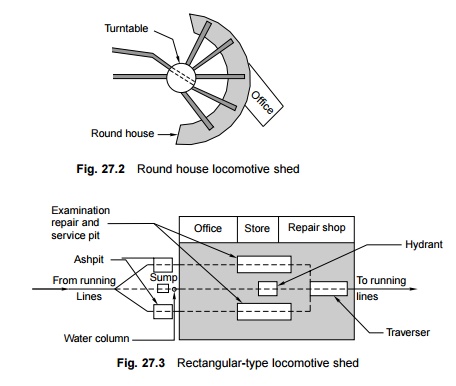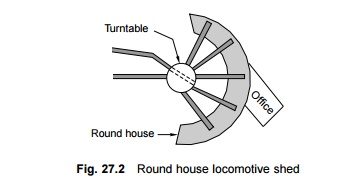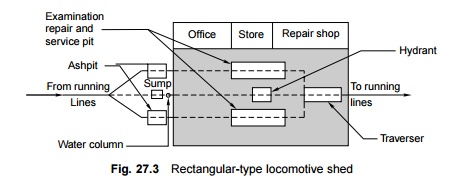Chapter: Civil : Railway Airport Harbour Engineering : Railway Engineering : Equipment at Railway Stations
Railways: Layout of Locomotive Sheds

Layout of Locomotive Sheds
The layout of locomotive sheds is normally of three different types, namely, round house type, rectangular type, and mixed type.
Round house locomotive shed
The round house shed (Fig. 27.2) consists of a number of locomotive repair and stabling lines radiating from a turntable in the centre. The shed is normally in the shape of a circle or a polygon. The incoming engine is taken to the turntable and transferred to a particular line for repair. The provision of a turntable eliminates the need for shunting.

The locomotive enters and leaves from the same end and, therefore, in the event of the turntable becoming inoperative, the movement of all the locomotives is discontinued until the turntable is repaired. This type of shed layout is not recommended for Indian Railways.
Rectangular-type locomotives shed
These sheds (Fig 27.3) are rectangular in shape and are most commonly used on Indian Railways. A rectangular-type shed can be a blind shed, a through shed, or a mixed-type shed. In the blind type of shed, all the repair bays terminate at dead ends and locomotives can enter and exit from one end only, thus leading to conflicts in the movement of the locomotives. However, these types of sheds are cheap because they save on the amount of space needed for tracks and turnouts at the rear end. Such rectangular sheds can be planned for small locomotive holdings.

In a through rectangular shed, the locomotives move from one end to the other in the correct sequence of the operations that are to be performed for servicing. Such a shed offers considerable scope for future expansion and tenders the maximum flexibility in shed operations.
Mixed-type shed
A mixed-type shed has the characteristics of both a blind and a through type. These sheds are suitable for locations that require expansion in the near future but lack the requisite.
Related Topics